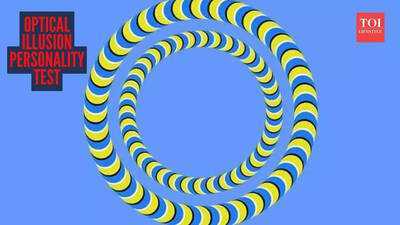Optical illusion personality test: Here's how the moving circles reveal your inner nature
ETimes November 24, 2025 03:39 AM
 Optical illusions often do more than entertain the eyes - they shed light on the subtle ways our minds interpret the world. The intriguing image above, featuring two concentric rings filled with alternating blue and yellow segments, is a perfect example. At first glance, everything looks still. But when you focus on it for a few seconds, the circles seem to come alive with motion, even though the image itself is perfectly static.
Optical illusions often do more than entertain the eyes - they shed light on the subtle ways our minds interpret the world. The intriguing image above, featuring two concentric rings filled with alternating blue and yellow segments, is a perfect example. At first glance, everything looks still. But when you focus on it for a few seconds, the circles seem to come alive with motion, even though the image itself is perfectly static.
This curious “movement” not only tricks your eyes but also hints at how your attention naturally works. According to this personality test, the circle that appears to move first - inner or outer - can reveal whether you lean more toward introversion or extroversion.
If the inner circle seems to move first…
You might possess traits commonly associated with introversion. People who notice the inner ring shifting before the outer one tend to be inward-focused. Their minds naturally gravitate toward the core of their thoughts and feelings before scanning what’s happening around them.
This doesn’t imply shyness or social withdrawal. Instead, it suggests a personality that values depth, reflection, and emotional detail. You may find comfort in smaller circles - both socially and mentally - and you likely draw strength from personal spaces, ideas, and quiet moments.
If the outer circle appears to move first…
You may align more with extroverted tendencies. Extroverts often process the world from the outside in, engaging with external cues before diving into inner thoughts. Spotting movement in the outer ring first points to a mind that scans the environment quickly, instinctively connecting with what’s happening around it.
This outward orientation often reflects energy, curiosity, and responsiveness. You’re likely someone who thrives in dynamic settings and enjoys being in tune with your surroundings.
Beyond introvert vs. extrovert
While this illusion offers an interesting angle on personality, it isn’t meant to be a scientific evaluation. Instead, it playfully highlights how perception, attention, and thought patterns can intertwine. Some viewers pick up on the shifting details at the center, while others detect the broader movement around the edges - both reactions reflect natural differences in how people focus and filter visual information.
Ultimately, this optical illusion serves as a fun reminder that our brains each process the world in unique ways. Whether you see the inner or outer circle “moving” first, the real takeaway is how fascinating and individual your perception truly is.
Image Credit: Pinterest
 Optical illusions often do more than entertain the eyes - they shed light on the subtle ways our minds interpret the world. The intriguing image above, featuring two concentric rings filled with alternating blue and yellow segments, is a perfect example. At first glance, everything looks still. But when you focus on it for a few seconds, the circles seem to come alive with motion, even though the image itself is perfectly static.
Optical illusions often do more than entertain the eyes - they shed light on the subtle ways our minds interpret the world. The intriguing image above, featuring two concentric rings filled with alternating blue and yellow segments, is a perfect example. At first glance, everything looks still. But when you focus on it for a few seconds, the circles seem to come alive with motion, even though the image itself is perfectly static.